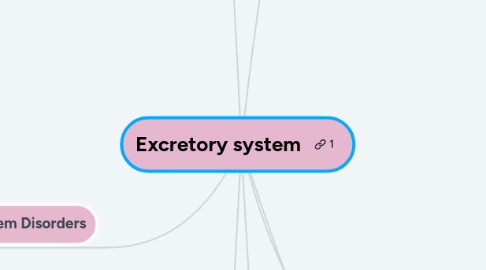
1. Skin
1.1. Skin function
1.1.1. 1. Excretion
1.1.2. 2. Protection
1.1.3. 3. Body temperature regulation
1.1.4. 4. Metabolism
1.1.5. 5. Communication
1.2. Skin structure
1.2.1. 1. Epidermis
1.2.1.1. a. Stratum corneum
1.2.1.2. b. Stratum Lusidum
1.2.1.3. c. Stratum granulosum
1.2.1.4. d. Stratum spinosum
1.2.1.5. e. Stratum basalis
1.2.2. 2. Dermis
1.2.2.1. a. Papillary layer
1.2.2.2. b. Reticular layer
1.2.3. 3. Hypodermis (subcutaneous)
2. Excretion System Disorders
2.1. Kidney disorders
2.1.1. 1. Glucosuria Excretion of glucose into the urine
2.1.2. 2. Albuminuria The kidneys cannot do screening process
2.1.3. 3. Diabetes mellitus Diabetes
2.1.4. 4. Kidney stones Sedimentation in the cavity kidney or bladder
2.1.5. 5. Diabetes insipidus Urine is plenty and watery is accompanied thirst
2.1.6. 6. Polyuria Increased frequency of BAK
2.1.7. 7. Kidney failure (anuria) Deep kidney failure produce urine
2.1.8. 8. Uremia Toxic state when blood contains a lot of urea
2.1.9. 9. Nephritis is inflammation of the nephrons in the kidneys caused by Streptococcus sp
2.2. Liver Disorders
2.2.1. 1. Cirrhosis of the liver Changing liver cells into fibrous connective tissue
2.2.2. 2. Hemochromatosis absorbs too much iron
2.2.3. 3. Liver
2.3. Skin Disorders
2.3.1. 1. Prickly sweat
2.3.2. 2. Hyperhidrosis
2.3.3. 3. Anhidrosis (can't sweat)
2.3.4. 4. Bromhidrosis (body odor)
2.3.5. 6. Kadas atau kurap
2.3.6. 6. Ringworm or ringworm
2.3.7. 7. Scabies
2.3.8. 8. Vitiligo (pigmentation disorders)
2.3.9. 9. Athlete's foot
2.3.10. 10. Pimples
2.3.11. 11. Cutaneous pruvitus
2.3.12. 12. Kalvus (fish eye)
2.4. Lung Disorders
2.4.1. 1. Lung cancer
2.4.2. 2. Asthma
2.4.3. 3. TBC
3. Excretion System Technology
3.1. 1. Hemodialysis (dialysis)
3.2. 2. Kidney transplant
3.3. 3. ESWL (Extracorporeal Shock Wave Lithotripsy) = destruction of urinary tract stones by using shock waves that are transmitted from outside the body
3.4. 4. Skin grafting
4. Heart
4.1. Liver function
4.1.1. Excretion tool by breaking down several compounds that are detoxifying
4.1.2. Produces ammonia, urea, and uric acid which will be excreted into the urine
4.1.3. Save glycogen
4.1.4. Activating vitamin D
4.1.5. Bacterial phagocytes by kupffer cells
4.1.6. Degradation of the hormone insulin and other hormones and degradation of ammonia to urea
4.2. Produce:
4.2.1. 1. Bile to help digest fat
4.2.2. 2. Thrombopoietin to control the production of blood pieces by the spinal cord
4.2.3. 3. Albumin as a component of blood plasma
4.2.4. 4. Angiotensinogen for increased blood pressure
4.2.5. 5. The arginase enzyme converts arginine to ornitine and urea
5. kidney
5.1. kidney function
5.1.1. 1. excreting metabolic substances such as ammonia
5.1.2. 2. Removal of toxic substances
5.1.3. 3. Arrangement of important ion balance in the body
5.1.4. 4. Setting acid base balance
5.1.5. 5. Maintain blood pressure through regulating the expenditure of salt and water
5.1.6. 6. Regulations of red blood cell production cells
5.1.7. 7. Control the concentration of blood nutrients
5.1.8. 8. Changing inactive vitamin to be active vitamin d
5.2. kidney structure
5.2.1. cortex (outer part)
5.2.1.1. there is a bowman capsule that serves to filter blood
5.2.1.2. kidney marrow which is a connection from the malpighi body
5.2.2. medulla (kidney marrow)
5.2.3. malpighi body (kidney cavity)
5.2.3.1. temporary urine reservoirs
5.3. process in the kidney
5.3.1. 1. Filtration
5.3.1.1. occur in glomerular capillaries
5.3.1.2. made easy by high hydraulic pressure and permeability on the glomerulus
5.3.2. 2. Re-absorption (reabsorption)
5.3.2.1. occur in the proximal tubule of the consortus
5.3.3. Augmentation
5.3.3.1. occurs in the distal tubule
5.4. things that affect urine production
5.4.1. Internal factors
5.4.1.1. External factors
5.4.1.1.1. The process of adding substances that are not needed in the distal contus tubule
5.4.1.1.2. 1. Ambient temperature
5.4.1.1.3. 2. The amount of water you drink
5.4.1.1.4. 3. Alcohol
5.4.1.2. 1. ADH hormone
5.4.1.3. 2. the hormone insulin
5.4.1.4. 3. The renin-angiotensin-aldosterone system
5.5. Urine characteristics
5.5.1. 1. Adult urine volume is 800-2,500 mL / day
5.5.2. 3. Urine specific gravity 1,003-1,035
5.5.2.1. 2. Pale yellow-dark yellow
5.5.3. 4. Characteristic
5.6. Urine Composition
5.6.1. 1. Nitrogen wastes
5.6.2. 2. Ketone objects
5.6.3. 3. Hipuric acid
5.6.3.1. 4. Toxins and electrolytes
